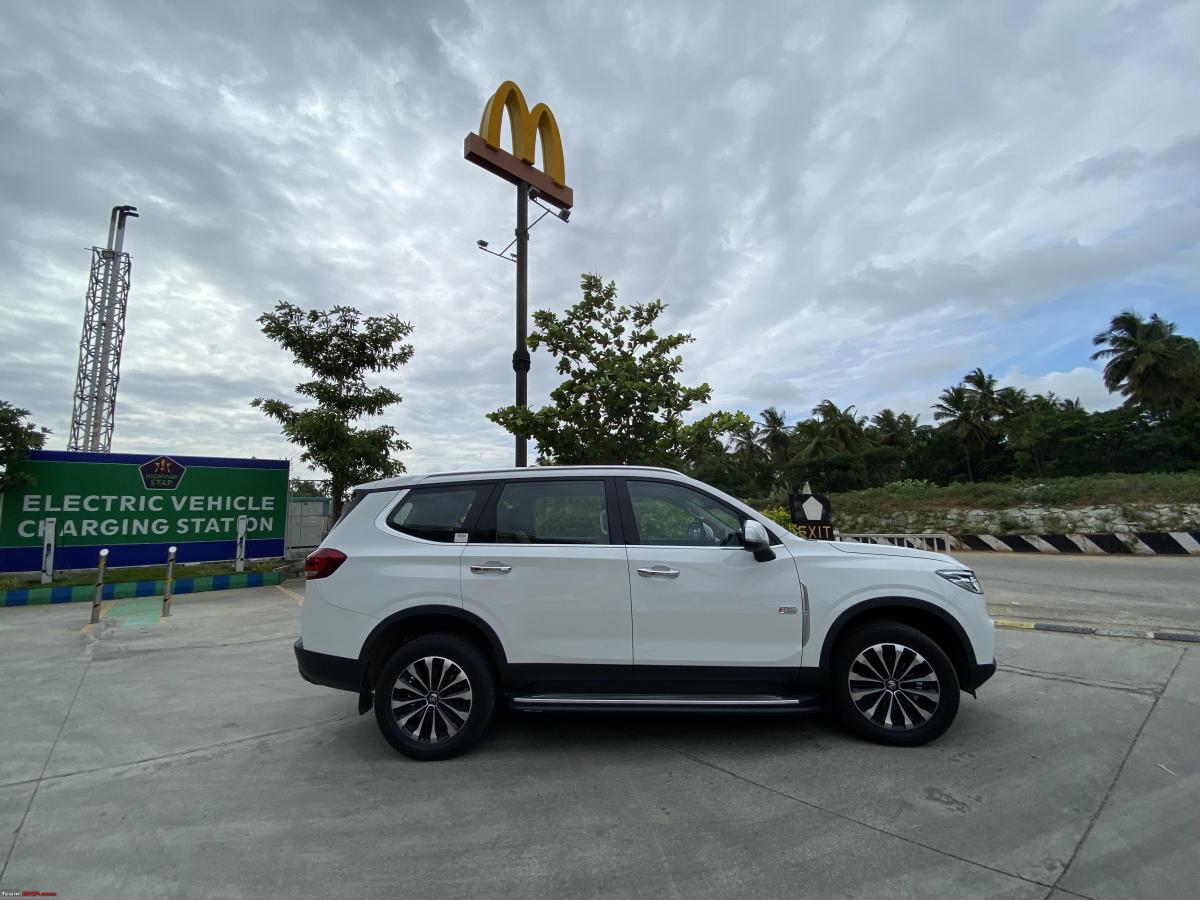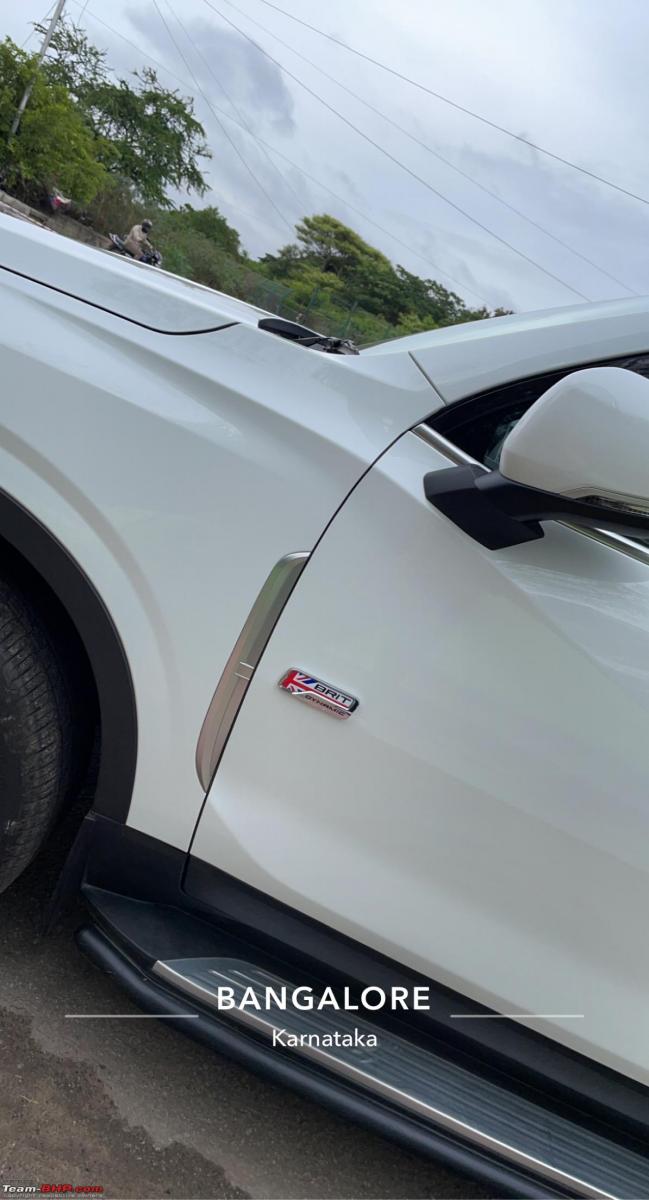Post the remap, the SUV’s driving experience began to resemble that of an old Audi Q7.
BHPian drstrange recently shared this with other enthusiasts.
Selecting the Gloster:
My requirement was a 7-seater to replace my Hexa, which I had owned for 5 years. I sought an SUV with excellent ride quality, seating comfort, 4-wheel drive, and go-anywhere ability within a budget of 35-45 lakhs. Shortlisted cars included:
Notably, models like Jeep Meridian, ScorpioN, and XUV 700 weren’t available during my purchase.
Toyota Fortuner:
- Pros: Excellent design, strong road presence, good resale value, torque, and pickup.
- Cons: Noisy, harsh engine, heavy steering, average seats without luxury.
- Reason for elimination: Heavy steering and loud engine.
Ford Endeavour:
- Pros: Striking design, strong road presence, 10-speed gearbox, excellent suspension, ride, handling, and steering.
- Cons: Aging model, anaemic 2.0-liter engine, rear seat not special.
- Reason for elimination: Preference for a 3.2-liter engine.
Isuzu MU-X:
- Pros: Isuzu reliability.
- Cons: Poor NVH, below-average suspension, lack of power, mediocre looks.
Tata Safari:
- Pros: Cost-effective, sturdy build, robust suspension, monocoque chassis.
- Cons: Average NVH, heavy steering, Tata service.
- Reason for elimination: Tata service, lack of AWD/4WD.
Mahindra Alturas G4:
- Pros: Luxurious cabin, smooth engine, light steering, good performance, excellent NVH.
- Cons: Average looks, SsangYong’s condition, lack of discounts.
- Reason for elimination: SsangYong’s situation.
Hyundai Alcazar:
- Pros: Feature-rich, good NVH, Hyundai reliability.
- Cons: Lack of AWD, less road presence, car-like feel.
- Reason for elimination: 1.5-litre engine, absence of AWD.
Kia Carnival:
- Pros: Strong pros across the board, Audi-like feel, powerful engine, comfortable seats.
- Cons: Unappealing looks, uncertain future, no AWD.
- Reason for elimination: No AWD.
This brings me to the Gloster:
Exterior:
The Gloster is massive, though the Fortuner boasts a better road presence. The front design is premium with sleek headlights and a large grille, while the side and rear quarters are less impressive. A design similar to the Harrier would have been better.
The interior is exemplary.
Front Seats:
The driver seat is comfortable with electronic adjustments, providing a commanding road view. Ventilation, heating, and massage functions are effective.
Rear Seats
The rear seats in my Gloster are individual captain seats. Although they lack height adjustment, they don’t feel as uncomfortable as the front co-passenger seat. Paired with the expansive panoramic sunroof, they provide a very airy and premium ambience. The seat back supports are excellent in terms of ergonomics. However, the rear seats are adjusted manually, without an electric adjustment option.
Dashboard: The dashboard can put cars twice the cost to shame, not only in terms of their appearance but also the quality of materials and tactile feel. Everything is immaculate; only when you look lower down can you find some inexpensive plastic bits, although this is a minor detail.
Infotainment:
The infotainment experience is a mixed bag.
Audio quality:
The speakers used are decent, but the amplification is weak and anaemic. We need to make significant adjustments to the equalizer to achieve a satisfactory sound quality.
Touch and responsiveness:
The touch response is passable, not great. However, the head unit itself is notably sluggish, resembling an old Windows XP PC upgraded to Windows Vista, struggling to perform efficiently. A major frustration is the frequent freezing of Apple CarPlay and Android Auto, requiring a hard reset to restore functionality.
One of the most poorly executed features is the reversing camera’s quality. It resembles an old Nokia phone camera or a dated CCTV camera, displaying significant noise, low resolution, and slow responsiveness. Aftermarket cameras provide a noticeably better image quality.
The built-in Gaana app is available, but it’s underwhelming to use. Unfortunately, there’s no option to download other music apps. The internet connectivity also proves to be buggy. Overall, the infotainment system’s performance is akin to a budget Android tablet, with its only standout feature being its appearance.
Air Conditioning:
The air conditioning works effectively, cooling the cabin rapidly. The controls are intuitive and easy to use.
Driver Console and Speedo:
The gear control knob exudes a premium feel, as does the front console. The car imparts a strong sense of luxury. The speedometer boasts a bright screen with good clarity, though it doesn’t reach the high resolution of Audi’s virtual cockpit. It comprises a blend of a digital screen positioned between two analogue dials. Notably, the puddle lamps also add a premium touch.
Driving Impressions after 2 Years of Ownership and the Need for an ECU Remap:
Experiencing the Gloster’s driving is something that truly requires firsthand experience. However, I’ll attempt to convey my impressions on paper. During my test drives, I primarily drove on highways in auto mode. What struck me the most were the seating position and the NVH levels. The suspension performance was outstanding, even surpassing that of my Hexa and my cousin’s Duster. It glides over rough patches and road undulations like a Titanic on water. As for body roll, it remains within acceptable limits for a car of this size and height. The steering is light and nimble, creating a sensation of floating. It’s as if the car is gliding on clouds. The suspension setup leans towards the softer side, noticeable when you step onto the footboard to perch on the driver’s seat.
These driving experiences have remained consistent over the two years of owning the car. However, what has dampened the experience is the response from the engine and gearbox.
Engine & Gearbox:
Illustrative description of a non-‘V’ twin-turbo engine configuration.
The engine is a 2.0 twin-turbo unit, a non-‘V’ configuration engine with two turbos. This setup isn’t mechanically robust due to its structure. It consists of two turbochargers: one is a high-pressure turbo that activates at lower RPMs, and the other is a low-pressure turbo that engages at higher RPMs. However, at certain points, the high RPM turbo can experience back pressure and manifold interference, affecting the vehicle’s reliability. To address this, the ECU is tuned to mitigate these issues and meet emission standards. In contrast, a ‘V’ configured engine has a more mechanically robust solution, with each line having a single turbo that doesn’t conflict at various RPMs.
Regarding the gearbox, it’s a weak link in the Gloster’s drivetrain. Its torque handling isn’t sufficient, and for reliability, it’s tuned to be quite sluggish… excessively so. Despite this, shifts are very smooth. With this combination of engine, gearbox, significant weight, and aerodynamics reminiscent of a skyscraper, the car comes to life around 2000 RPM, delivering a sudden surge of torque that fades after 3500 RPM. When I initially test-drove the car on highways, this wasn’t as evident. However, after purchasing it and experiencing various road and traffic conditions, especially in the city or slow-moving highway traffic, driving the vehicle became a challenge. It feels unresponsive, lifeless below 2000 RPM, with a sudden and aggressive torque spike at 2000 RPM that quickly disappears. This drivetrain characteristic made driving the car difficult and uninspiring. After a year or so, the car felt devoid of character. I even preferred to hand the keys to my chauffeur rather than take the wheel in the Gloster.
This drivetrain behaviour isn’t improved by changing drive modes, whether it’s eco, auto, or sport. Modes like sand, mud, ruts, and rock are meant for poor road conditions, and using them for performance enhancement doesn’t make sense. I preferred using eco mode, which offers the best NVH levels. While it didn’t drastically change the driving experience, it did upshift early, with the 8th gear engaging around 80 km/h, resulting in better cruising. In sport mode, the car held 7th gear until reaching 100-110 km/h. It’s important to note that the Gloster isn’t designed for confident high-speed handling. It’s stable only up to 140 km/h, beyond which its underpowered engine and aerodynamics hinder performance. Coupled with body roll, it doesn’t inspire confidence to push beyond that speed.
The brakes are best described as average; they don’t match the car’s weight and require a forceful push on the brake pedal for effective stopping. With these drawbacks in the drivetrain, I researched ways to eliminate turbo lag. I explored online forums and information about the engine, but there was limited info available. I stumbled upon a video by Doughnut Media about a $ 2,500 electronic turbo, which fascinated me. Unfortunately, I couldn’t find anyone in India installing it, as it required a mild hybrid 48-volt system with large batteries placed in the car’s boot. This was disappointing, as the Gloster is an otherwise brilliant car, marred by poor drivetrain tuning. This is important because, on paper, the numbers are impressive: 218 bhp, 480 Nm of torque, and a 0-100 sprint in 11 seconds. The main issue lies in the narrow power band, with the car feeling unresponsive below 2000 RPM.
I came across Code 6 in Hyderabad, where Mr. Anirudh provided technical expertise. I inquired about electronic turbo installation, and while he initially laughed it off, we discussed the lacklustre drive I was experiencing with my Gloster. He assured me that an ECU remap could address the issue, enhancing throttle response and torque curve linearity. Convinced by his advice, I travelled to Hyderabad, nearly 500 km from my city. Anirudh swiftly completed the work in just 45 minutes, assuring me that if there were future ECU updates, he’d reflash the ECU for free – a generous gesture.
After the remap, I immediately noticed improved NVH levels, making an already brilliant aspect of the car even better. Notably, the engine now pulled cleanly from as low as 1400 RPM, infusing new life into the car. The torque delivery was remarkable, with a robust surge of power in the lower rev range. This transformed the car from feeling like a train compartment to a powerhouse. The previously sluggish gearbox was now complemented by the engine’s performance. Throttle responses and pedal-to-metal reactions drastically changed. It began to resemble an old Audi Q7 in terms of driving experience.
During a trip to Bhadrachalam via Maredumalli, I utilized the sports mode with a heavy right foot in the mountainous terrain. Fuel efficiency suffered, returning 5 km/l, and my AdBlue consumption increased. I contacted Mr Anirudh, who assured me that the ECU flash would stabilize after a few kilometres. As the initial excitement waned, I began using the car more conservatively, opting for auto mode instead of aggressive driving in sports mode. This change improved fuel economy to around 10-10.5 km/l, slightly lower than the pre-remap average of 11-11.5 km/l. Since the remap, I’ve covered approximately 8000 km.
I’m eagerly anticipating upgraded brakes, as they have the potential to significantly enhance the car’s performance. Improved braking would elevate the Gloster to the league of German SUVs in terms of driving experience. This enhancement would make the SUV even more desirable, showcasing its virtues such as interior quality, ride comfort, and excellent NVH levels, which have been further improved. Addressing one of its major drawbacks, the power delivery, would be the icing on the cake.
I strongly recommend that Gloster owners who self-drive consider getting an ECU remap. I’m also interested in learning about other members’ upgrades in terms of performance or braking for their Glosters.
Proudly displaying the “Code 6 Tuned” badge!
Check out BHPian comments for more insights and information.
Source: Read Full Article










